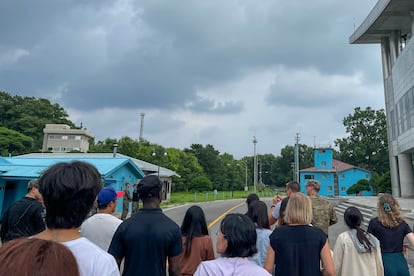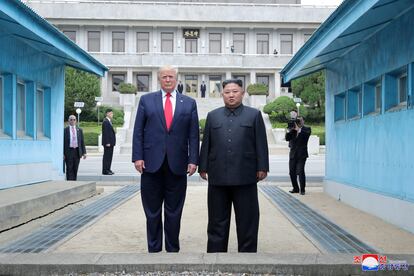Travis King: The mysteries surrounding the US soldier detained in North Korea
Almost a week after his detention, it’s still unclear what prompted the private to leave the Seoul airport, join a tour of the DMZ and cross into the country


Nearly a week after his detention for crossing into North Korea in a Cold War-esque episode, there are more questions than answers in the case of Travis King, a U.S. soldier whose fate is now in the hands of one of the world’s most secretive and ruthless regimes.
The most pressing questions are: where is he being detained and what do Pyongyang authorities plan to do with him. Meanwhile, in Washington, the focus is on what could have prompted King to cross into North Korea. Was he deserting to avoid punishment? Was it a joke that got out of hand? Or, as the wildest speculations suggest, was this a bungled intelligence plan?
What is known, based on investigations by U.S. media and the scant official information available, is that Private 2nd Class King’s decision to cross the 150-mile-long Demilitarized Zone (DMZ) that has separated North and South Korea since the end of the Korean War in 1953 has put the United States in a difficult predicament. The U.S. does not maintain diplomatic relations with Pyongyang. What’s more, King’s detention comes at one of the worst possible moments, with tensions high over the recent deployment of a US nuclear submarine in South Korea and North Korea’s launch of several ballistic missiles.
King enlisted in the military in January 2021. He was stationed in South Korea. It is not known exactly when he arrived in the Asian country, where the United States has 28,500 soldiers deployed. It appears that he rotated through various units: from the Sixth Squad to the First Armored Division from Fort Bliss. King was scheduled to land at that Texan base last Tuesday, when he decided to become the first U.S. soldier to enter North Korea since 1982. His superiors were sending him back home for disciplinary reasons: King had been involved in an altercation last October. He was found guilty of two counts of assault and fined by a South Korean court for, among other things, damaging a police car, according to Reuters. He spent 50 days by behind bars in South Korea, and was released on July 10.

Officers escorted him to the airport seven days later, but only to customs, as they were not authorized to pass this point with him. In the United States, he was set to face disciplinary action, but nothing serious. Before he was detained on Tuesday, he spoke to his mother, Claudine Gates, who told the ABC television network that he sounded calm. “I can’t see Travis doing anything like that,” said Gates.
Indeed, it is not clear to anyone why King crossed into North Korea. After passing customs, the soldier decided to leave the boarding area of Seoul airport and join a tour of the Demilitarized Zone in the border town of Panmunjom — the only place where contacts between the two Koreas are authorized.
Tens of thousands of tourists tour the DMZ every year (up to 100,000 before the pandemic), but always in an organized group and with prior authorization. This raises another question: why didn’t alarms go off when King’s passport was checked?
“The most dangerous place in the world”
That morning, King was part of a group of 43 tourists from around the world who heard the stories that every visitor is told: that Bill Clinton called this site “the most dangerous place in the world,” that the prisoner exchanges on the Bridge of No Return stopped in 1968, and that two American soldiers, Arthur Bonifas and Mark Barrett, were by North Korean soldiers in 1976 after pruning a poplar tree that had allegedly been planted by then-North Korean leader Kim Il-sung.
The tour also takes visitors to the Joint Security Area, which is made up of bright United Nations-blue buildings. It’s where former U.S. president Donald Trump met North Korean leader Kim Jong-un in 2019, and where other high-profile visits are made. Visitors are told North Korea constantly monitors the Joint Security Area and that any wrong move can be fatal. According to witnesses, who didn’t realize the man on the tour dressed in jeans and a T-shirt was a soldier, that’s where King started running north. Sarah Leslie, a tourist from New Zealand, said she thought it was a joke. “I assumed initially he had a mate filming him in some kind of really stupid prank or stunt, like a TikTok, the most stupid thing you could do,” Leslie told AP. “But then I heard one of the soldiers shout, ‘Get that guy.’”

No American has ever crossed into North Korea from the Joint Security Area before, even though only a small line of bricks separates the country. Indeed. Trump became the first U.S. president to set foot in North Korea by stepping over that boundary.
The last American to enter North Korea was Bruce Byron Lowrance, who crossed from China in 2018 and was held for a month before being released. In 2016, U.S. college student Otto Warmbier entered as a tourist and was accused of attempting to steal a propaganda poster as a souvenir. He was sentenced to 15 years in prison, but returned to the United States in a coma after being held for 17 months. According to U.S. authorities, he was beaten by authorities in Pyongyang. He died shortly after returning home.
The last time a U.S. soldier crossed into North Korea was back in 1982, when Joseph White defected to the country. He died three years later, allegedly in a drowning accident. But the most famous case is that of Charles Jenkins, who deserted his post in South Korea in 1965 to avoid being sent to Vietnam. He was allowed to leave North Korea in 2004. He died in Japan in 2017. The following year, Pyongyang released the last three known U.S. detainees as part of an unsuccessful plan to thaw the frosty relations between the two countries.
On Tuesday, following King’s detention, Defense Secretary Lloyd Austin said he was worried about the soldier’s fate. “We’re closely monitoring and investigating the situation,” he said. Austin added that the United States had tried to communicate with North Korean authorities. The United Nations Command has started talks with North Korea about King, according to Reuters. This raises yet another question about the case: how does Pyongyang intend to leverage King in its endless tug-of-war with the West? So far, true to its legendary secrecy, North Korea has remained silent on the issue.
Sign up for our weekly newsletter to get more English-language news coverage from EL PAÍS USA Edition
Tu suscripción se está usando en otro dispositivo
¿Quieres añadir otro usuario a tu suscripción?
Si continúas leyendo en este dispositivo, no se podrá leer en el otro.
FlechaTu suscripción se está usando en otro dispositivo y solo puedes acceder a EL PAÍS desde un dispositivo a la vez.
Si quieres compartir tu cuenta, cambia tu suscripción a la modalidad Premium, así podrás añadir otro usuario. Cada uno accederá con su propia cuenta de email, lo que os permitirá personalizar vuestra experiencia en EL PAÍS.
¿Tienes una suscripción de empresa? Accede aquí para contratar más cuentas.
En el caso de no saber quién está usando tu cuenta, te recomendamos cambiar tu contraseña aquí.
Si decides continuar compartiendo tu cuenta, este mensaje se mostrará en tu dispositivo y en el de la otra persona que está usando tu cuenta de forma indefinida, afectando a tu experiencia de lectura. Puedes consultar aquí los términos y condiciones de la suscripción digital.
More information
Archived In
Últimas noticias
Most viewed
- Sinaloa Cartel war is taking its toll on Los Chapitos
- Oona Chaplin: ‘I told James Cameron that I was living in a treehouse and starting a permaculture project with a friend’
- Reinhard Genzel, Nobel laureate in physics: ‘One-minute videos will never give you the truth’
- Why the price of coffee has skyrocketed: from Brazilian plantations to specialty coffee houses
- Silver prices are going crazy: This is what’s fueling the rally










































